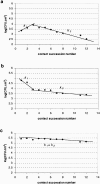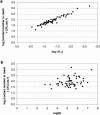Construction and analysis of fractional multifactorial designs to study attachment strength and transfer of Listeria monocytogenes from pure or mixed biofilms after contact with a solid model food
- PMID: 16597925
- PMCID: PMC1449066
- DOI: 10.1128/AEM.72.4.2313-2321.2006
Construction and analysis of fractional multifactorial designs to study attachment strength and transfer of Listeria monocytogenes from pure or mixed biofilms after contact with a solid model food
Abstract
The aim of this study was to establish which of seven factors influence the adhesion strength and hence bacterial transfer between biofilms containing Listeria monocytogenes (pure and two-species biofilms) and tryptone soya agar (TSA) as a solid organic surface. The two-species biofilms were made of L. monocytogenes and one of the following species of bacteria: the nonpathogenic organisms Kocuria varians, Pseudomonas fluorescens, and Staphylococcus sciuri and CCL 63, an unidentified gram-negative bacterium isolated from the processing plant environment. We used biofilms prepared under conditions simulating open surfaces in meat-processing sites. The biofilm's adhesion strength and population were evaluated by making 12 contacts on a given whole biofilm (4.5 cm(2)), using a new slice of a sterilized TSA cylinder for each contact, and plotting the logarithm CFU . cm(-2) detached by each contact against the contact number. Three types of detachment kinetics were observed: biphasic kinetics, where the first slope may be either positive or negative, and monophasic kinetics. The bacteria that resisted a chlorinated alkaline product and a glutaraldehyde- and quaternary ammonium-based disinfectant had greater adhesion strengths than those determined for untreated biofilms. One of the four non-Listeria strains studied, Kocuria varians CCL 56, favored both the attachment and detachment of L. monocytogenes. The stainless steel had smaller bacterial populations than polymer materials, and non-Listeria bacteria adhered to it less strongly. Our results helped to evaluate measures aimed at controlling the immediate risk, linked to the presence of a large number of CFU in a foodstuff, and the delayed risk, linked to the persistence of L. monocytogenes and the occurrence of slightly contaminated foods that may become dangerous if L. monocytogenes multiplies during storage. Cleaning and disinfection reduce the immediate risk, while reducing the delayed risk should be achieved by lowering the adhesion strength, which the sanitizers used here cannot do at low concentrations.
Figures



Similar articles
-
Interactions in biofilms between Listeria monocytogenes and resident microorganisms from food industry premises.Int J Food Microbiol. 2004 Dec 15;97(2):111-22. doi: 10.1016/j.ijfoodmicro.2004.03.031. Int J Food Microbiol. 2004. PMID: 15541798
-
Transfer of microorganisms, including Listeria monocytogenes, from various materials to beef.Appl Environ Microbiol. 2002 Aug;68(8):4015-24. doi: 10.1128/AEM.68.8.4015-4024.2002. Appl Environ Microbiol. 2002. PMID: 12147503 Free PMC article.
-
Dynamics of biofilm formation by Listeria monocytogenes on stainless steel under mono-species and mixed-culture simulated fish processing conditions and chemical disinfection challenges.Int J Food Microbiol. 2018 Feb 21;267:9-19. doi: 10.1016/j.ijfoodmicro.2017.12.020. Epub 2017 Dec 19. Int J Food Microbiol. 2018. PMID: 29275280
-
Lactic Acid Bacteria (LAB) and Their Bacteriocins as Alternative Biotechnological Tools to Control Listeria monocytogenes Biofilms in Food Processing Facilities.Mol Biotechnol. 2018 Sep;60(9):712-726. doi: 10.1007/s12033-018-0108-1. Mol Biotechnol. 2018. PMID: 30073512 Review.
-
Comprehensive strategies for controlling Listeria monocytogenes biofilms on food-contact surfaces.Compr Rev Food Sci Food Saf. 2024 May;23(3):e13348. doi: 10.1111/1541-4337.13348. Compr Rev Food Sci Food Saf. 2024. PMID: 38720587 Review.
Cited by
-
A Look inside the Listeria monocytogenes Biofilms Extracellular Matrix.Microorganisms. 2016 Jul 5;4(3):22. doi: 10.3390/microorganisms4030022. Microorganisms. 2016. PMID: 27681916 Free PMC article. Review.
-
Current Knowledge on Listeria monocytogenes Biofilms in Food-Related Environments: Incidence, Resistance to Biocides, Ecology and Biocontrol.Foods. 2018 Jun 5;7(6):85. doi: 10.3390/foods7060085. Foods. 2018. PMID: 29874801 Free PMC article. Review.
-
Listeria monocytogenes - How This Pathogen Survives in Food-Production Environments?Front Microbiol. 2022 Apr 26;13:866462. doi: 10.3389/fmicb.2022.866462. eCollection 2022. Front Microbiol. 2022. PMID: 35558128 Free PMC article. Review.
-
Risk Comparison of the Diarrheal and Emetic Type of Bacillus cereus in Tofu.Microorganisms. 2019 Nov 7;7(11):536. doi: 10.3390/microorganisms7110536. Microorganisms. 2019. PMID: 31703304 Free PMC article.
-
Initial Transcriptomic Response and Adaption of Listeria monocytogenes to Desiccation on Food Grade Stainless Steel.Front Microbiol. 2020 Jan 22;10:3132. doi: 10.3389/fmicb.2019.03132. eCollection 2019. Front Microbiol. 2020. PMID: 32038566 Free PMC article.
References
-
- Addelman, S. 1962. Orthogonal main-effect plans for asymmetrical factorial experiments. Technometrics 4:21-46.
-
- Allison, D. G., and I. W. Sutherland. 1987. The role of exopolysaccharides in adhesion of freshwater bacteria. J. Gen. Microbiol. 133:1319-1327.
-
- Autio, T., R. Keto-Timonen, J. Lunden, J. Bjorkroth, and H. Korkeala. 2003. Characterisation of persistent and sporadic Listeria monocytogenes strains by pulsed-field gel electrophoresis (PFGE) and amplified fragment length polymorphism (AFLP). Syst. Appl. Microbiol. 26:539-545. - PubMed
-
- Briandet, R., V. Leriche, B. Carpentier, and M. N. Bellon-Fontaine. 1999. Effects of the growth procedure on the surface hydrophobicity of Listeria monocytogenes cells and their adhesion to stainless steel. J. Food Prot. 62:994-998. - PubMed
MeSH terms
Substances
LinkOut - more resources
Full Text Sources
Research Materials

